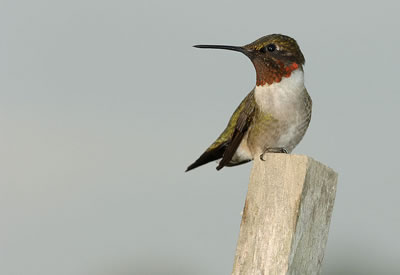Ruby-Throated Hummingbird

Facts about creatures
- Home
- Animal Classification
- Animal Habitats
- Amphibians
- Arthropods
- Bats
- Birds
- Carnivorans
- Cetaceans
- Chordates
- Crustaceans
- Dinosaurs
- Diprotodonts
- Elephants
- Fish
- Golden Mole
- Insects
- Lagomorphs
- Mammals
- Mammal Teeth
- Marsupial Mole
- Metamorphosis
- Mollusks
- Primates
- Reptiles
- Rodents
- Ruminants
- Soricomorphans
- Tenrec
- Tetrapods
- Vertebrates
Ruby-Throated Hummingbird
The ruby-throated hummingbird gets its name from the ruby patch that the male has on his throat.
Ruby-throated hummingbirds are tiny birds, each weighing less than a tenth of an ounce. They are about 2 ½ to 3 ½ inches long, with wingspans of about 3 to 4 ½ inches.
Female ruby-throated hummingbirds are larger than males.
Both males and females have emerald feathers on their backs. Their underparts are gray or white. The female has a gray or white throat patch and white spots on her trail.

The ruby-throated hummingbird undergoes a long, grueling migration each year, sometimes flying across the Gulf of Mexico without stopping.
It breeds in the prairies of Canada and in the continental United States east of the Mississippi and flies to Mexico, Central America or the West Indies in the winter.
Ruby-throated hummingbirds are the only hummingbirds that breed in eastern North America.
During breeding season, ruby-throated hummingbirds can be found in deciduous forests, as well as in gardens, backyards and parks.
They live in forests, scrubland, citrus groves and hedgerows in the winter.
Amazing Flyers
The wings of a ruby-throated hummingbird beat, on average, about 53 times per second. They can reach speeds of 80 beats a second.
To the naked eye of a human being, the ruby-throated hummingbird’s wings look like whirling helicopter propellers.
Like all hummingbirds, ruby-throated hummingbirds can fly straight up, straight down, and backwards. They can also hover.
Diet
The diet of the ruby-throated hummingbird consists of nectar, sap, spiders and insects.
Ruby-throated hummingbirds can pick insects out of the air.
Sometimes, they will snatch insects out of spider webs.
They can see into the ultraviolet spectrum and prefer to feed from flowers that are red or orange
Red clothing may attract them.
A ruby-throated hummingbird may need to eat two times its body weight in food in a single day to meet its enormous energy requirements.
Ruby-throated hummingbirds eat very often during the day. They enter a state of torpor – in which their metabolic rate decreases significantly – at night and when they cannot find food.
Before migrating, a ruby-throated hummingbird may eat enough food to double its weight, to gain fuel for its long journey.
Breeding
Ruby-throated hummingbirds are solitary birds. They usually only associate with each other during mating season.
They are polygamous
To attract a mate, the male performs a diving display in which his wings may beat 200 times in one second.
Mating does not last very long and the pair to do not stay together after mating is completed.
The female builds the nest and raises the young herself.
The nest of a ruby-throated hummingbird is built high in the branch of a tree or shrub. The nest, which is deep and cup-shaped, is about the size of a thimble. It is made of moss and soft plant materials, such as thistle down, dandelion or cattail.
Spider webs, and pine resin, if available, are used to hold the nest together.
The outside of the nest is decorated with tiny pieces of lichen, which help to camouflage it.
A clutch usually contains 1 to 3 eggs.
The nest stretches as the young birds grow.
Sometimes, ruby-throated hummingbirds will build nests on wires or fences.